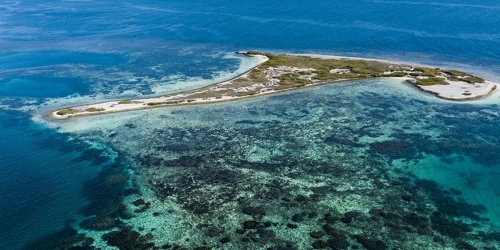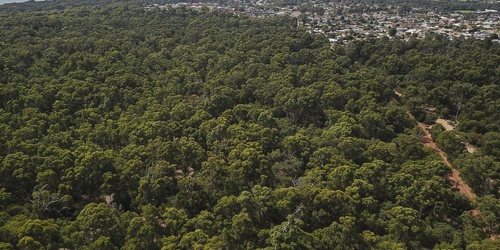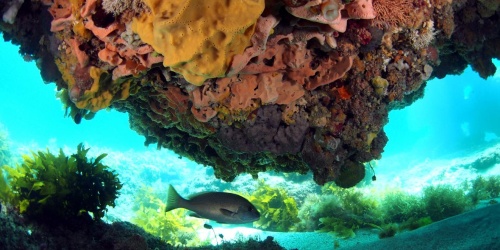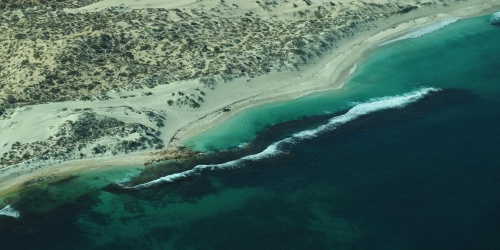View the Minister's media statement
The interactive map below shows the final management zones that come into operation in late 2026. The South Coast Marine Park has a mix of zones, including; general use, sanctuary, special purpose zone (wildlife conservation), special purpose zone (whale conservation), and special purpose zone (cultural protection).
Final management plans for the South Coast Marine Park will be published in late November 2024.
Note: the four marine parks on the south coast fall within four Native Title determination areas: Wagyl Kaip and
Southern Noongar, The Esperance Nyungars, Ngadju and WA Mirning People. Importantly, they are managed
as one interconnected ecological system – the 'South Coast Marine Park'.
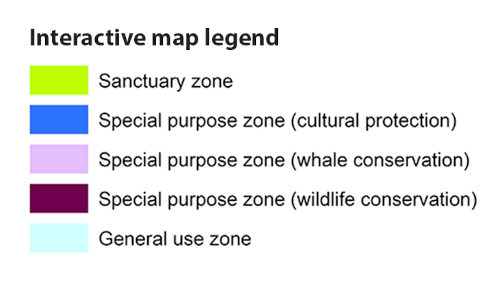
If you prefer hard-copy maps, you can download and print the following maps showing where you can fish recreationally in the marine park.
Map 1 - Bremer Bay to Cape Arid
Map 2 - Bremer Bay to Mason Bay
Map 3 - Mason Bay to Butty Harbour
Map 4 - Butty Harbour to Yokinup Bay
Map 5 - Yokinup Bay to Israelite Bay
Map 6 - Israelite Bay to Point Dover
Map 7 - Point Dover to WA/SA border
Background
A marine park on the south coast of Western Australia has been created as part of the State Government’s Plan for Our Parks.
Scientific studies have shown the marine biodiversity of south coast state waters is globally significant. The south coast marine environment supports vast kelp forests and extensive rhodolith beds, productive reefs and islands, marine species found nowhere else such as the ruby sea dragon, southern right whale nursery areas, seal and sea lion colonies and important fisheries.
The marine park is culturally important and will be jointly managed with the area’s Traditional Owners, who are partners in the planning process.
The park extends from Bremer Bay east to the South Australian border, and offshore to the limit of State waters.
The park allows for sustainable commercial and recreational activities such as fishing, tourism, diving and boating. No take zones protect areas of diverse habitats of high ecological importance, and their boundaries have been designed to minimise impact on recreational and commercial fishers as much as possible, as the area’s great value to fisheries is recognised.
Community engagement
Local community input and knowledge was crucial to planning for the marine park.
Consultation
DBCA with the Traditional Owners of the four marine parks and DPIRD, undertook a rigorous process of engaging with key stakeholders, including commercial and recreational fishers, community members and marine scientists. This involved:
- The establishment of a Community Reference Committee (CRC) that met six times over the 18 months up to March 2023. Following a request from members, the final CRC meeting was deferred for an additional month to allow stakeholders, including fishers, more time to consider unresolved matters.
- 10 different Sector Advisory Groups (SAGs) comprised representatives from key stakeholder groups involved in activities within the proposed marine park.
- Separate from the CRC process, DBCA also conducted 31 individual meetings in Albany, Hopetoun, Esperance, and Perth with commercial fishers and seven with recreational fishers. Importantly, every commercial fishing business with a license in the south coast was contacted and each given the opportunity to meet 1:1 with DBCA.
- DBCA and DPIRD representatives met with a range of stakeholders including the Shire of Esperance and fishing peak bodies.
- Public submissions on the South Coast Marine Park were open for four months until 16 June 2024. More than 22,000 individuals and organisations made submissions during the most thorough consultation process ever undertaken for a proposed marine park in Western Australian history.
Previous media statements and newsletters
Media statements
Zoning scheme for world-class South Coast Marine Park released 5 November 2024
Record submissions made on proposed South Coast Marine Park 18 June 2024
Still time to have your say on proposed South Coast Marine Park 4 June 2024
Have your say on the proposed South Coast Marine Park 16 February 2024
New marine park for WA’s south coast one step closer 29 March 2023
Online mapping tool to help shape proposed south coast marine park 14 March 2022
Marine park Community Reference Committee members appointed 25 November 2021
Consultation underway on new marine park for the south coast 24 September 2021
Newsletters
Register to receive regular updates via the Proposed South Coast Marine Park Newsletter.
Special Edition, Communique – Meeting 5, Nov-Dec 2022
Special Edition, Communique - Meeting 4, Aug-Sept 2022
Special Edition, Communique - Meeting 3, June 2022
Special Edition, Communique – Meeting 2, March 2022
Reports and fact sheets
Frequently asked questions
Why do we need a marine park on the South Coast?
- WA’s south coast is globally recognised for its diverse marine life, however, less than one per cent of State waters on the south coast are currently protected as marine reserves.
- It will provide important protections to marine species, such as the unique ruby seadragon, which is not found anywhere else in the world.
- The area is also home to southern right whale nurseries, vast kelp forests, vulnerable seal and sea lion colonies, precious reefs, and important fisheries.
Where is the marine park?
- The South Coast Marine Park covers more than 1000 kilometres of coastline from Bremer Bay to the South Australian border.
When was the public submission period?
- The four indicative management plans for the proposed SCMP were released for a four-month public comment period from 16 February to 16 June 2024.
- The consultation process for the proposal was the State’s most successful with a record number of submissions received via online survey forms, proformas, letters and emails.
How many public submissions were made?
- More than 22,000 public submissions were received on the proposed SCMP management plans, the most ever for a proposed marine park in Western Australia.
What was the main feedback from submissions?
- Many submissions supported the creation of the marine parks, called for strengthened protections with increased sanctuary zones, and supported joint management with Traditional Owners and the protection of cultural values.
- There were also proforma submissions which supported sustainable fishing in the park and called for adequate compensation for any affected local commercial fishers.
- Major themes from written and online submissions were protection of recreational fishing, boating and the safety of those who fish, along with concerns with the rationale for the marine park and the consultation process.
- Many written and online submissions suggested setbacks of proposed sanctuary zones from the shore of between 100-500 metres to allow more recreational beach fishing.
- Another key theme of the written and online submissions was protection for recreational and family activities and traditions, and protection for tourism, economic development and coastal lifestyles.
What is the final zoning scheme?
- Significant time and effort has been taken to develop a final zoning scheme that maintains protection of ecological values while better providing for recreational, commercial and customary fishing access and aquaculture interests.
- The zoning scheme comprises general use, sanctuary, special purpose zone (wildlife conservation), special purpose zone (whale conservation) and special purpose zone (cultural protection). The proposed special purpose zones (cultural protection) prioritise protecting the value of the waters to the culture and heritage of Aboriginal people.
- Zoning consists of:
- Twenty-nine sanctuary zones (20 per cent of the parks)
- Nine special purpose zones (cultural protection) (four per cent of the parks)
- Three special purpose zones (whale conservation) (six per cent of the parks)
- Two special purpose zone (wildlife conservation) (less than one per cent of the parks)
- The remainder is general use zone (70 per cent of the parks).
How much of the proposed marine park is open to fishing?
- Locals and visitors can continue to fish, with approximately 80 per cent of the marine park remaining available for fishing.
- Approximately 85 per cent of the mainland coast immediately adjacent to the proposed marine parks remains available for shore-based fishing where there has been historical recreational fishing.
- Boundaries of some sanctuary zones have been offset to an approximate distance of 200 metres from the mainland high water mark (distance varies depending on coastline features), to better allow for fishing from and close to shore.
- Sanctuary zones have been located away from jetties and boat ramps to maintain recreational fishing access.
- The Esperance Port area adjacent to the proposed marine parks remains accessible and available for shore and boat based recreational fishing access.
What are the next steps?
- Final management plans will be published on the DBCA website.
- New zoning will be enforceable from late 2026. It is best practice to start abiding by these rules now in preparation.
What financial assistance is being provided to impacted commercial fishers?
- Commercial fishers who hold an authorisation and suffer a loss arising from the creation of a marine park in WA may be eligible for compensation under the Fishing and Related Industries Compensation (Marine Reserves) Act 1997.
- DPIRD is responsible for administering the Fishing and Related Industries Compensation (Marine Reserves) Act but is also exploring alternative adjustment or compensation measures for commercial fishers who may be impacted by the establishment of the marine park.
